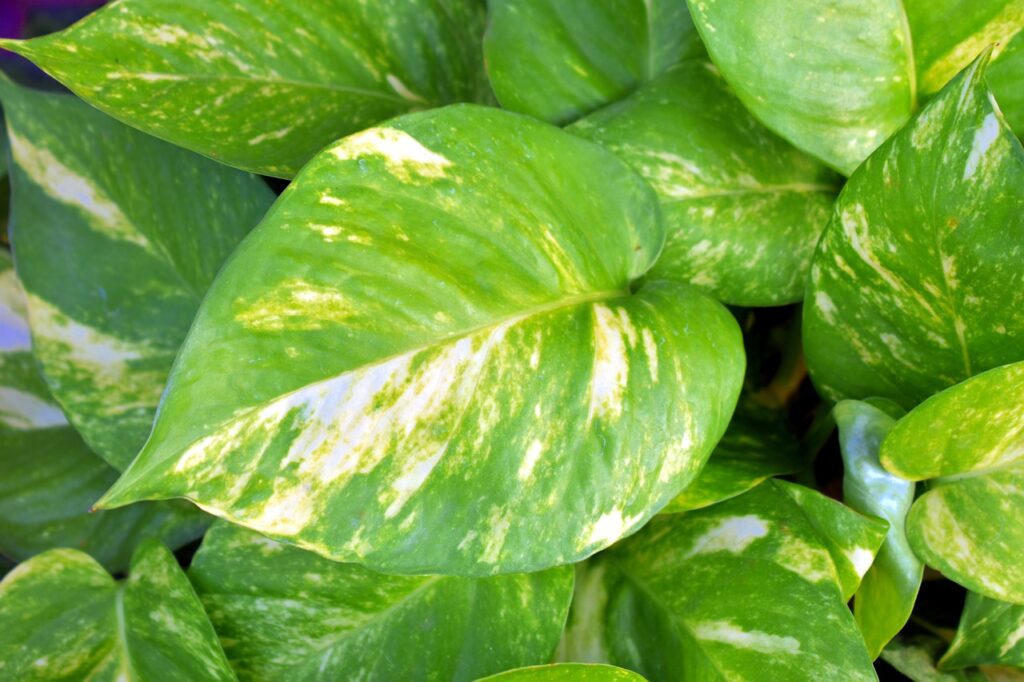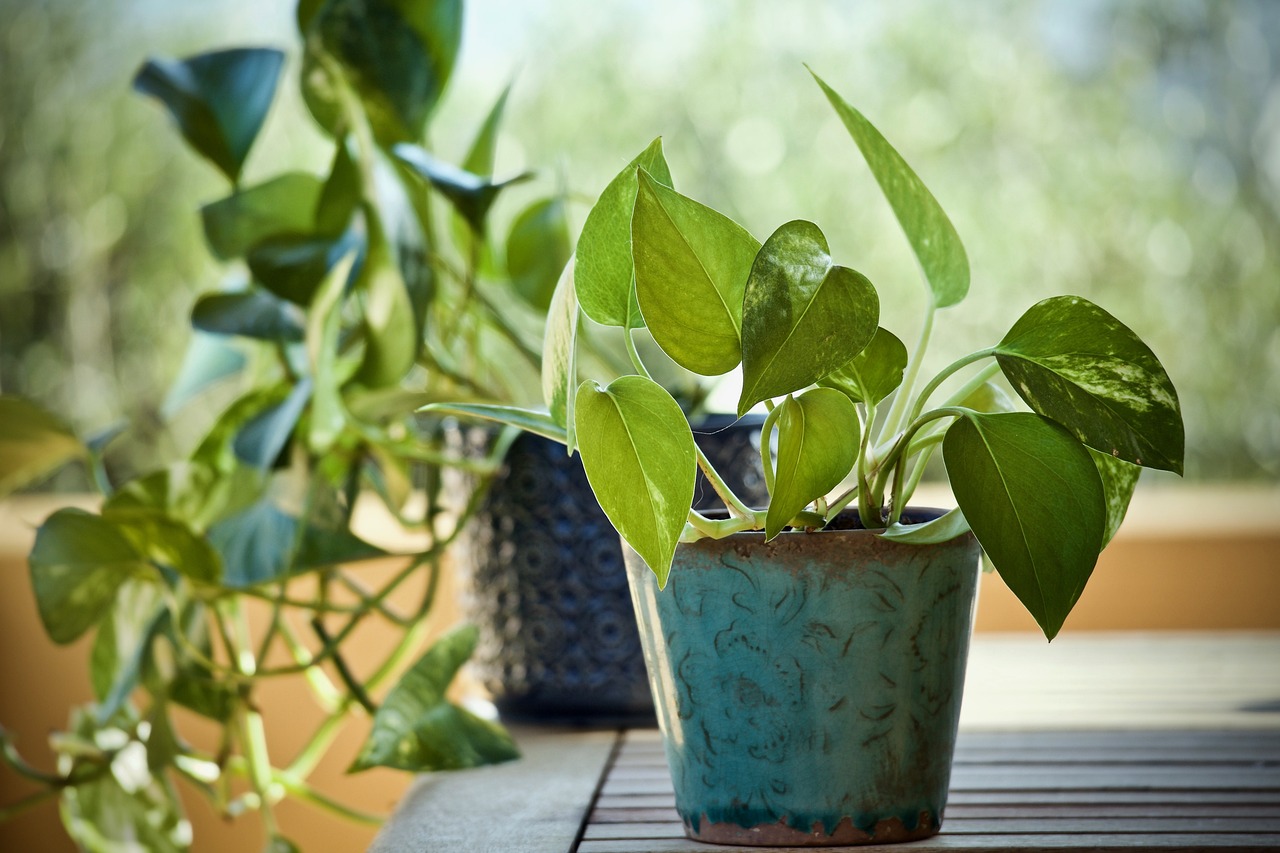
Introduction:
- What is Epipremnum?
- Overview of Epipremnum, commonly known as Pothos, Devil’s Ivy, or Golden Pothos, a versatile and popular houseplant.
- Easy-to-grow, low-maintenance plant native to Southeast Asia and the Solomon Islands.
- Known for its heart-shaped, variegated leaves and fast-growing nature.
1. Botanical Overview of Epipremnum:

- Family and Species:
- Epipremnum belongs to the Araceae family, which includes other well-known plants like Monstera and Philodendron.
- The most common species, Epipremnum aureum, is commonly referred to as Pothos, though there are several cultivars with different leaf colors and patterns.
- Plant Characteristics:
- Epipremnum is a climbing vine or trailing plant that can grow long, cascading stems or be trained to climb on supports like trellises or moss poles.
- Leaves are typically glossy, with variegated patterns of green, yellow, and white, though some cultivars feature solid green or neon yellow leaves.
- Known for its ability to adapt to various lighting conditions and for being an excellent air-purifying plant.
2. Ideal Growing Conditions for Epipremnum:
- Light:
- Prefers bright, indirect light but can also tolerate low light conditions.
- In low light, the variegation on the leaves may diminish, and growth may slow down.
- Avoid placing the plant in direct sunlight, as it can scorch the leaves.
- Temperature:
- Thrives in warm temperatures between 65°F–85°F (18°C–29°C).
- Avoid placing in cold drafts or areas with temperatures below 50°F (10°C), as it is sensitive to cold.
- Humidity:
- Epipremnum is adaptable to average humidity levels but will thrive in higher humidity.
- In dry environments, consider using a humidifier or placing the plant on a humidity tray.
- Mild humidity boosts the plant’s growth and prevents browning leaf edges.
- Soil:
- Prefers well-draining potting soil with a slightly acidic to neutral pH (6.1–7.0).
- A standard houseplant mix or a cactus/succulent mix with added perlite works well to ensure good drainage.
3. Watering Epipremnum:
- Watering Basics:
- Water when the top 1–2 inches of soil are dry to the touch. Typically, this means watering every 1-2 weeks.
- Always check soil moisture before watering to avoid overwatering or underwatering.
- Signs of Overwatering:
- Yellowing leaves, mushy stems, or root rot (smelly, soft roots).
- Ensure the pot has proper drainage and never let the plant sit in water.
- Signs of Underwatering:
- Drooping leaves, dry leaf edges, or a shriveled appearance in the stems.
- Epipremnum can tolerate occasional underwatering, but it’s best to maintain a consistent watering schedule.
- Watering Tips:
- Use room-temperature water to avoid shocking the plant’s roots.
- If the leaves are drooping or showing signs of stress, check the soil’s moisture level first before deciding to water.

4. Fertilizing Epipremnum:
- When to Fertilize:
- Fertilize every 4-6 weeks during the growing season (spring and summer).
- In fall and winter, reduce or stop fertilizing, as the plant’s growth slows down during these months.
- Type of Fertilizer:
- Use a balanced liquid fertilizer (e.g., 10-10-10) diluted to about half strength.
- Organic fertilizers, like compost tea or worm castings, can also be beneficial for more sustainable care.
- How to Fertilize:
- Apply fertilizer during the watering routine after the soil has been moistened to avoid burning the roots.
- Don’t fertilize when the plant is stressed or dormant.
- Signs of Over-Fertilizing:
- Yellowing leaves, brown tips, and excess salt buildup on the surface of the soil.
- Signs of Under-Fertilizing:
- Slow growth, pale or washed-out foliage, or the plant looking “starved” for nutrients.
5. Common Issues and How to Solve Them:
- Yellowing Leaves:
- Causes: Overwatering, underwatering, nutrient deficiency, or pest infestations.
- Solutions: Check watering habits, ensure good drainage, and provide proper light and nutrients.
- Brown Leaf Tips:
- Causes: Low humidity, underwatering, or over-fertilizing.
- Solutions: Increase humidity, water more regularly, or cut back on fertilizer.
- Leggy Growth:
- Causes: Insufficient light or the plant becoming root-bound.
- Solutions: Move the plant to a brighter location and prune to promote more compact growth.
- Pests:
- Common pests: Spider mites, mealybugs, aphids, and scale.
- Solutions: Regularly inspect the plant, wipe leaves with a damp cloth, and treat infestations with insecticidal soap or neem oil.
- Root Rot:
- Causes: Overwatering, poor drainage, and constantly soggy soil.
- Solutions: Check the roots, trim away any rotting sections, and repot the plant in fresh, well-draining soil.
6. Pruning and Maintenance:
- Why Prune Epipremnum?
- Pruning helps control the plant’s size, shape, and spread.
- It encourages bushier, fuller growth and prevents the plant from becoming too leggy.
- When to Prune:
- Prune during the growing season (spring and summer) when the plant is actively growing.
- Remove any dead or damaged leaves, and trim long stems to promote lateral growth.
- How to Prune:
- Use clean, sharp scissors or pruning shears to cut back any unwanted growth.
- Cut just above a node (the small bump where leaves or roots emerge) to encourage branching.
- Maintaining Shape:
- Regularly pinch back new growth to maintain a bushier, more compact appearance.
- Don’t be afraid to trim back leggy vines if the plant becomes unruly.
7. Repotting Epipremnum:
- When to Repot:
- Repot every 1-2 years or when the plant becomes root-bound (roots growing out of the drainage holes or when the plant’s growth slows).
- Signs it’s time to repot include roots pushing through drainage holes or soil that dries out too quickly.
- Best Potting Tips:
- Choose a pot 1-2 inches larger in diameter than the current pot to allow for future growth.
- Ensure the new pot has adequate drainage holes.
- Repotting Steps:
- Gently remove the plant from its pot, shake off old soil, and inspect the roots for signs of rot.
- Place the plant in a new container with fresh, well-draining soil, and water lightly after repotting.
8. Propagation of Epipremnum:
- How to Propagate:
- Epipremnum is very easy to propagate from stem cuttings.
- Take a cutting with at least 1-2 nodes (small bumps where leaves and roots emerge).
- Place the cutting in water or moist soil, and it will root in 1-3 weeks.
- Propagation Tips:
- Use sharp, clean scissors to prevent disease transmission.
- Keep the cutting in bright, indirect light, and change the water every few days if propagating in water.
- Once roots are established, the cutting can be transferred to soil.
- Speed of Propagation:
- Epipremnum cuttings root relatively quickly in water (within 2-4 weeks).
- For soil propagation, the rooting process may take a bit longer.
9. Benefits of Owning Epipremnum:
- Aesthetic Appeal:
- The vibrant, variegated foliage adds a beautiful touch of greenery and color to any space.
- Its trailing vines and ability to climb make it a versatile plant for shelves, hanging baskets, or as a decorative floor plant.
- Low Maintenance:
- Epipremnum is one of the easiest plants to care for, making it a perfect choice for beginners and busy plant owners.
- Air Purification:
- Epipremnum is an excellent air purifier, removing toxins like formaldehyde, benzene, and xylene from the air.
10. Fun Facts About Epipremnum:
- Name Origin: Epipremnum comes from the Greek words epi (upon) and premnon (stem), referring to the plant’s habit of climbing or attaching to tree trunks.
- Nicknames: Pothos is the most common name, but it’s also known as Devil’s Ivy due to its reputation for being nearly indestructible and thriving in a variety of conditions.
- Historical Use: The plant has been used in tropical gardens and is often found in commercial buildings for its air-purifying properties.
11. Additional Resources:
Here’s a list of reputable, non-commercial resources where you can find reliable information on Pothos (Epipremnum aureum) care and houseplant maintenance:
1. The Spruce
- Website: thespruce.com
- The Spruce offers a wealth of plant care articles written by experienced horticulturists and gardening experts. Their pothos care guides are easy to follow, providing advice on light, watering, propagation, and troubleshooting.
2. University of Florida IFAS Extension
- Website: edis.ifas.ufl.edu
- The University of Florida’s Institute of Food and Agricultural Sciences provides detailed and research-backed information on a variety of houseplants, including Pothos. Their content is academically rigorous and trusted by professionals.
3. Missouri Botanical Garden
- Website: missouribotanicalgarden.org
- Known for its well-researched plant care guidelines, the Missouri Botanical Garden provides thorough care instructions and facts about Pothos and other houseplants, focusing on native and tropical species.
4. Royal Horticultural Society (RHS)
- Website: rhs.org.uk
- The RHS is one of the world’s leading plant organizations. Their website contains trusted plant care information, including advice on growing and caring for common houseplants like Pothos.
5. American Horticultural Society
- Website: ahsgardening.org
- A great resource for gardeners in the U.S., the American Horticultural Society provides plant care guides and gardening tips from experienced horticulturists, including information about Pothos care and maintenance.
6. The Plant Lover’s Guide (by the Royal Horticultural Society)
- Website: rhs.org.uk
- This book and associated articles are written by top horticulturalists. It includes practical, detailed plant care tips, specifically for tropical houseplants, such as pothos.
7. Dave’s Garden
- Website: davesgarden.com
- Dave’s Garden is a community-driven website where gardeners share experiences and plant care tips. You’ll find firsthand advice and personal experiences about growing and caring for Pothos plants.
8. Plant Care Today
- Website: plantcaretoday.com
- A trusted website for plant care, Plant Care Today provides easy-to-understand and accurate guides on the best care practices for a variety of houseplants, including Pothos.
9. Gardenia.net
- Website: gardenia.net
- This resource offers detailed care information for houseplants, with a focus on tropical and easy-care varieties like Pothos. The advice is thorough and regularly updated.
10. Houseplant Central
- Website: houseplantcentral.com
- A great source for houseplant enthusiasts, Houseplant Central provides expert tips on plant care, including how to care for Pothos, troubleshoot issues, and propagate them successfully.
These sources provide a solid foundation for learning more about Pothos care and general houseplant care practices. They’re reliable, fact-based, and respected within the plant care community.

